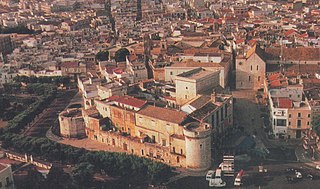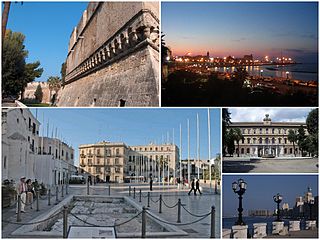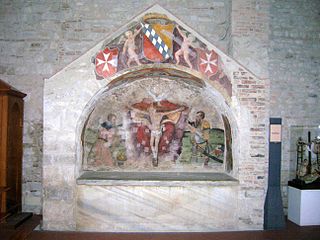Alexander (died after 1142) was the second count of Conversano (1085–1132), the son and successor of Geoffrey the Elder.

Conversano is an ancient town and comune in the Metropolitan City of Bari, Apulia, south-eastern Italy. It is 30 kilometres (19 mi) southeast of Bari and 7 kilometres (4 mi) from the Adriatic coast, at 219 metres (719 ft) above sea level.
Geoffrey the Elder was an Italo-Norman nobleman. A nephew of Robert Guiscard through one of his sisters, he was the count of Conversano from 1072 and the lord of Brindisi and Nardò from 1070, until his death.
Alexander, with his brother Tancred, was a constant thorn in the side of Roger II of Sicily. He took part in a civil war that broke out in Bari. Risone, the archbishop of the city, was murdered (1117) and the princess of Taranto, Constance of France, was imprisoned at Giovinazzo (1119) by Grimoald Alferanites, the prince of Bari, and Alexander.
Tancred of Conversano, the youngest son of Geoffrey, Count of Conversano, became the count of Brindisi on his father's death.

Roger II was King of Sicily, son of Roger I of Sicily and successor to his brother Simon. He began his rule as Count of Sicily in 1105, became Duke of Apulia and Calabria in 1127, and then King of Sicily in 1130. By the time of his death at the age of 58, Roger had succeeded in uniting all the Norman conquests in Italy into one kingdom with a strong centralized government.

Bari is the capital city of the Metropolitan City of Bari and of the Apulia region, on the Adriatic Sea, in southern Italy. It is the second most important economic centre of mainland Southern Italy after Naples and Palermo, a port and university city, as well as the city of Saint Nicholas. The city itself has a population of 326,799, as of 2015, over 116 square kilometres (45 sq mi), while the urban area has 700,000 inhabitants. The metropolitan area has 1.3 million inhabitants.
After Roger was defeated at the Battle of Nocera in 1132, Tancred returned to the Mezzogiorno and entered into open rebellion again, taking the cities of Montepeloso and Acerenza, with the support of their populations. He raised a force with his brother Tancred, Count Godfrey of Andria, Count Ranulf of Alife, and Prince Robert II of Capua. Roger crossed the Straits of Messina with a large force and Alexander was so afraid that he abandoned his city of Matera to his son, Geoffrey the Younger, and fled to the court of Ranulf. After Roger's successfully besieged Matera, Alexander, deeply grieved, fled to Dalmatia. He was deprived of his fief and unable to return home. He tried to meet up with the Emperor Lothair II, but was set upon by thieves in a forest. According to Alexander of Telese, he was left in the town of Valona very poor.

The Battle of Nocera or Scafati was the first major battle of Roger II of Sicily and one of two of his major defeats at the hands of Count Ranulf of Alife.

Acerenza is a town and comune in the province of Potenza, in the Southern Italian region of Basilicata.

Robert II was the count of Aversa and the prince of Capua from 1127 until his death.
In 1142, near the end of his life, he appears as an envoy along with Robert of Capua of Conrad III of Germany to the Byzantine Emperor John II Comnenus. Their mission was the arrangement of a marriage between Conrad's sister-in-law Bertha of Sulzbach and John's son Manuel. This marriage sealed an alliance between the two empires, Holy Roman and Byzantine, against Roger of Sicily.

Conrad III was the first King of Germany of the Hohenstaufen dynasty. He was the son of Duke Frederick I of Swabia and Agnes, a daughter of the Salian Emperor Henry IV.
Bertha of Sulzbach was a Byzantine Empress by marriage to Byzantine Emperor Manuel I Comnenus.
On the same day in 1135 that he made his son Alfonso prince of Capua, Roger made his brother-in-law Robert I of Basunvilla, "a man in the flower of his youth", as Alexander of Telese says, "both affable and most active in knightly deeds", count of Conversano.
This page is based on this
Wikipedia article Text is available under the
CC BY-SA 4.0 license; additional terms may apply.
Images, videos and audio are available under their respective licenses.

William I, called the Bad or the Wicked (Sicilian: Gugghiermu lu Malu, was the second King of Sicily, ruling from his father's death in 1154 to his own in 1166. He was the fourth son of Roger II and Elvira of Castile.
The Principality of Taranto was a state in southern Italy created in 1088 for Bohemond I, eldest son of Robert Guiscard, as part of the peace between him and his younger brother Roger Borsa after a dispute over the succession to the Duchy of Apulia.
Guaimar III was the Lombard prince of Salerno from around 994 to his death. Under his reign, Salerno entered an era of great splendour. Opulenta Salernum was the inscription on his coins. He made Amalfi, Gaeta and Sorrento his vassals and annexed much of Byzantine Apulia and Calabria.

Alfonso, also called Anfuso or Anfusus, was the Prince of Capua from 1135 and Duke of Naples from 1139. He was an Italian-born Norman of the noble Hauteville family. After 1130, when his father Roger became King of Sicily, he was the third in line to the throne; second in line after the death of an older brother in 1138. He was the first Hauteville prince of Capua after his father conquered the principality from the rival Norman Drengot family. He was also the first Norman duke of Naples after the duchy fell vacant on the death of the last Greek duke. He also expanded his family's power northwards, claiming lands also claimed by the Papacy, although he was technically a vassal of the Pope for his principality of Capua.
Tancred of Hauteville, the second son of King Roger II of Sicily and his first wife, Elvira of Castile, was the Prince of Bari and Taranto from 1132 to 1138.

Abelard of Hauteville was the eldest son of Humphrey, count of Apulia and Calabria (1051–1057), and his Lombard wife, Gaitelgrima of Salerno, also known as Altrude. He was supposed to inherit his father's lands, but Robert Guiscard, his uncle and guardian, who was elected count on Humphrey's death, confiscated them.
Grimoald Alferanites was the prince of Bari from 1121 to 1132.
Ranulf II was the count of Alife and Caiazzo, and duke of Apulia. He was a member of the Italo-Norman Drengot family which dominated the Principality of Capua for most of the century between 1050 and 1150. Ranulf's wife, Matilda, was the sister of King Roger II of Sicily.

Sergius VII was the thirty-ninth and last duke of Naples. He succeeded his father John VI on the Neapolitan throne in 1122 at a time when Roger II of Sicily was rising rapidly in power. When Roger succeeded as duke of Apulia in 1127 and was crowned king in 1130, the fate of Naples hinged on Sergius' relations with the Sicilian court.

Roger III was the eldest son of King Roger II of Sicily and Elvira of Castile. He was the Duke of Apulia from 1134 until his death.
Robert was the first Norman count of Montescaglioso.
Robert I of Bassunvilla was a Norman baron from Molise. His family originated in Vassonville, near Dieppe.

The Hauteville was a Norman family originally of seigneurial rank from the Cotentin. The Hautevilles rose to prominence through their part in the Norman conquest of southern Italy. By 1130, one of their number, Roger II, was made the first King of Sicily. His male-line descendants ruled Sicily until 1194. Some Italian Hautevilles took part in the First Crusade and the founding of the Principality of Antioch (1098).
The Drengots were a Norman family of mercenaries, one of the first to head to the Mezzogiorno of Italy to fight in the service of the Lombards. They became the most prominent family after the Hautevilles.
Guarin was the chaplain and chancellor of Roger II of Sicily from about 1130 to his death, during the first decade of the Norman kingdom of Sicily. According to Alexander of Telese, the contemporary chronicler, he was "erudite ... and most prudent in negotiations ... a cleric well-versed in letters, skillful in matters of the world, and possessed of a tenacious and cautious mind."

The Norman conquest of southern Italy lasted from 999 to 1139, involving many battles and independent conquerors. In 1130 these territories in southern Italy united as the Kingdom of Sicily, which included the island of Sicily, the southern third of the Italian Peninsula, the archipelago of Malta and parts of North Africa.

Richard was the Italo-Norman count of Rupecanina.













